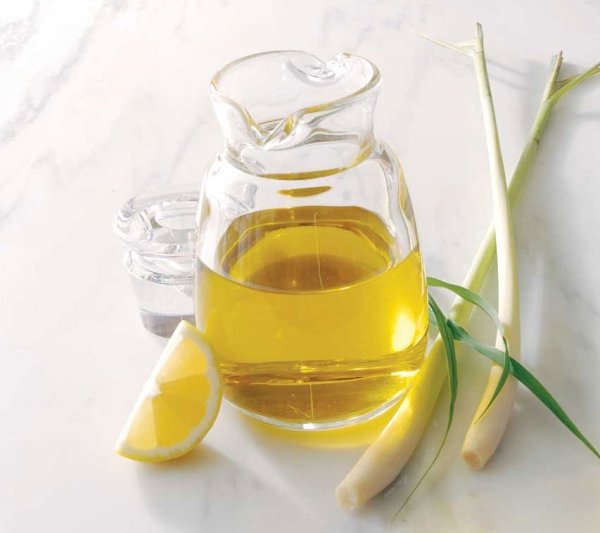Extracting lemongrass oil from plant material can be done in several ways. Two popular methods, tincturing and hot infusion, result in a medicinal oil to be taken orally in hot tea or straight onto the tongue or as therapeutic, topical oil. Lemongrass is said to act as a fungicide when applied topically or to aid in digestion when taken as a tea. It can be purchased in certain markets or stores that cater to an Asian clientele, as it is used primarily as an ingredient in Thai cuisine.

Lemongrass Essential Oil
1. Break fresh lemongrass stalks and fill the canning jar halfway with them. Breaking the stalks allows the natural oils to be released from the plant and strengthen the tincture.
2. Fill the jar half with alcohol and half with cold water. Vodka or brandy are the most common alcohols for making tinctures, but gin is used as well. Purchase the best quality liquor you can. If for whatever reason you cannot use alcohol, a half-and-half solution of white or apple cider vinegar and water is a suitable substitution. The potency of the medicine will be only slightly lessened by using vinegar and it will make the tincture safe for people who may have adverse reactions to alcohol.
3. Cover the lid and gently shake the herbs and alcohol solution. Allow the herbs to settle and look to see that all the plant material is covered by liquid. Even a small bit peeking out could mold during the tincturing process, ruining your tincture. Add more liquid if need be.
4. Place the medicine in a cool, dark room and wait three days. Then, pour the solution into a blender and blend the plant material. This will allow greater absorption between plant material and the liquid, particularly because lemongrass is such a woody plant. Put the blended liquid back into the jar and store for at least three weeks.
5. Strain the liquid from the plant material. Put a colander over a pot and lay a cheesecloth over the colander. Dump the tincture in and make a bundle with the plant material and cheesecloth. Squeeze as much liquid as you can out of the lemongrass.
6. Pour the tincture into a clean glass jar and store until ready to use. Tinctures are commonly taken directly on the tongue but adding the medicine to a cup of warm tea or water may be a more palatable solution.
Making a Hot Oil Infusion
7. Pour 1 cup of extra virgin olive oil into the top pan of a double boiler. Do not cover the pot.
8. Crush half a stalk of lemongrass, chopping if necessary, and place it in the oil. Do not let any water get into the oil or it will ruin the infusion. Don’t wash the lemongrass before you put it in the pot. If it is still wet from the market, let it dry before placing it in the oil.
9. Heat the double boiler until the water on the bottom begins to steam. Turn it down to a gentle simmer. Infuse the lemongrass in the oil for at least an hour, but the longer the better. Be sure to check on the water in the bottom pan to make sure it hasn’t all evaporated.
10. Cool the oil down and strain the herbs through a mesh strainer. Use the oil as a topical ointment or as a soothing massage oil.
Tips & Warnings
To sweeten the tincture and help mask some of the vinegar taste, add a teaspoon of honey directly into a vinegar-and-water tincture solution and allow it to steep along with the herbs. Honey will not affect the tincture in any way other than taste.
How to Extract Myrcene From Lemongrass
Extract the myrcene from lemongrass to add to your homemade perfumes.
Myrcene is obtained from essential oils. It can be found in several plant species including bay, Ylang-Ylang, hops, wild thyme and lemongrass. Once the essential oil has been extracted from the plant, myrcene acts as the main ingredient in perfumes. There are several ways in which essential oils can be extracted from the lemongrass plant, as it has long served as an herbalist remedy, including one which utilizes items you will have at home. You can extract your own oil from lemongrass and use it as an ingredient in homemade products.
Instructions
1. Wash the lemongrass stalks and cut into small pieces. Cutting the grass will help to release the oils.
2. Place the lemongrass into the wide-mouth jar. Fill the jar with oil. You can choose from several kinds of oil. Choose an oil that has a light color and little odor. Good options include olive oil, sesame oil, safflower oil or almond oil.
3. Put the lid on tightly and place in a sunny windowsill for 48 hours. Shake the jar every 12 hours.
4. Remove the lid and place the muslin cloth over the top of the jar. Drain the oil into the mixing bowl. Squeeze oil from the lemongrass in the muslin cloth.
5. Refill the jar halfway with fresh, chopped lemongrass. Pour the oil back in and place the closed jar in the windowsill for another 48 hours. Repeat this process until the oil contains enough myrcene to have the scent you desire. This process is known as enfleurage.
6. Expedite the process by placing the jar into a pot of cold water every day. Heat the oil until the water is warm to the touch. Leave the jar in the pot for 10 minutes. This process is known as maceration.
7. Mix the myrcene with other ingredients to make perfume.
Source: ehow.com
Photo: motherearthliving.com
Nice info, but this is not how you make a true essential oil. For a true essential oil you need a distiller.